|
Wisley's Alpine Log
By Paul Cumbleton
Log 18 28th August 2008
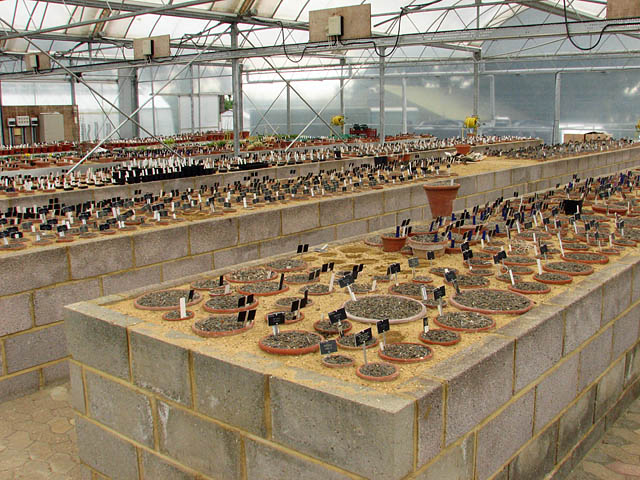
Rovero bulb house
The picture above shows the poly-house where we keep most of our bulb collections. With over 4000 pots, re-potting the bulbs each year is a mammoth task. As Ian describes in his bulb log, we would ideally like to do our re-potting immediately before they come into growth again, but the sheer numbers involved make this impossible. In fact we start our re-potting in late June and carry on until October, and even then we sometimes run out of time before growth starts and we have missed the boat. But most years we just about manage it.
We use what we call our "general bulb mix" for many of our bulbs, varying this sometimes for any we think may want something a bit different. This mix is:
1 part grit
1 part perlite
2 parts John Innes compost no. 2 or 3
(Parts are by volume)
The grit is a good "chunky" 6mm diameter size which looks like this:
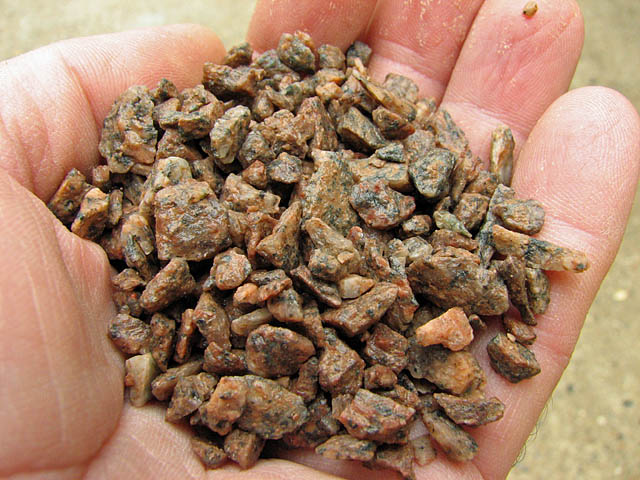
6mm diameter grit
Using coarse grade grit like this helps to ensure good drainage (fine sands should definitely be avoided!). Also helping with drainage, the perlite is also the coarsest grade we can get (called "supercoarse") and looks like this:
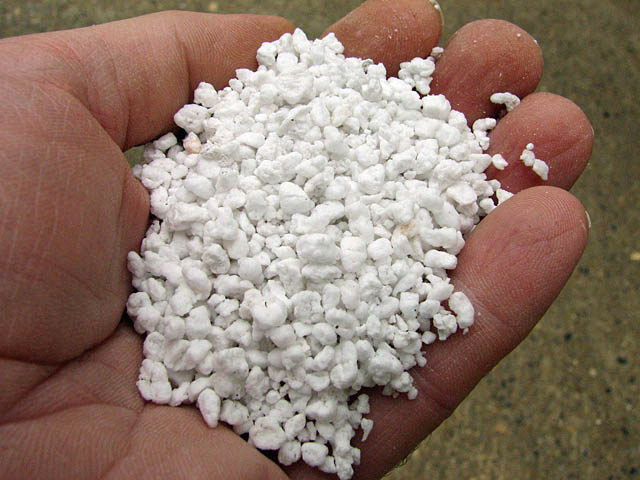
Supercoarse perlite
Perlite is also a good way to add air to the mix, as it is porous and the pores are mainly air-filled. This is because unlike in a sponge, the pores are not inter-connected. This means that when perlite is wetted, water doesn't get into all the pores. In fact, perlite only holds about 10% of its volume as water when wet, with the rest being mainly air.
The John Innes we use is of good quality and looks like this:

John Innes compost
Perhaps it would be useful to describe more about John Innes compost, especially for the benefit of overseas readers, as John Innes is a very British product and not really known or used elsewhere. As this will be quite a bit of writing with no pictures, I will leave it to the end of this log so scroll down if you are interested.
Anyway, back to our bulb mix. Once we have measured out the ingredients, we mix them using an electric concrete mixer - we get through too much to mix it all by hand!
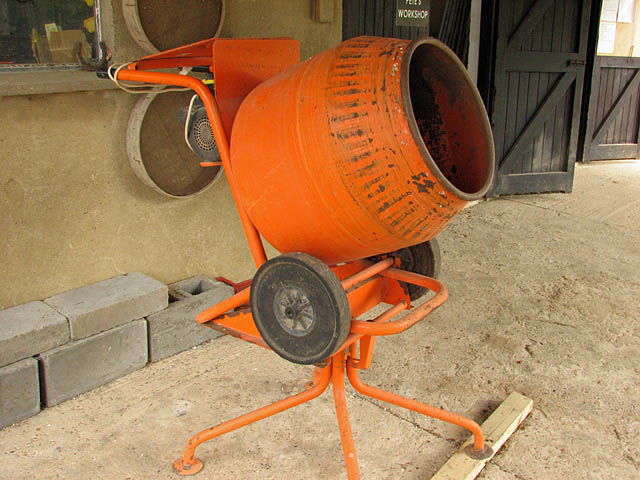
Our mixing machine
To the mix we add some extra fertiliser, as bulbs in pots are hungry things. We make up our own fertiliser mix according to an old formula invented by E.B. Anderson. The story I was told (which I have no idea if true!) is that he used this to great effect but no-one knew just what it was until after his death when the formula was found in his notes. As he was a chemist by training he probably understood these chemicals well. Anyway, his fertiliser consists of:
2 parts Superphosphate
1 part dried blood
1 part dolomitic limestone powder
1 part potassium sulphate
(Parts by volume)
We add this to our mix at a rate of 4g per litre of compost - which is a bit more than Anderson himself used but seems to work for us.
While talking about growing mediums, Alan Bryan contacted me after the log about Ponerorchis, with the following information:
"I noticed the bit about the fine clay pebbles that the Japanese use, not being available in this country. In fact this stuff sounds exactly like Tesco's Premium lightweight cat litter, which has been used for some time now by cactus and succulent growers. It is about the texture of rather coarse sand and does not disintegrate when wet. In fact it seems to be identical to a very fine grade of Seramis, being a sort of soft porous clay. It retains water yet gives very good drainage and aeration (extremely good for rooting cactus cuttings in). It has a scent added to it, for obvious reasons (!), but this doesn't seem to affect plant growth and dissipates after a while. It is about a fiver for a large sack!"
Alan kindly sent pictures of the cat litter:

Cat Litter
To ensure you get the right one, this is what the pack looks like:
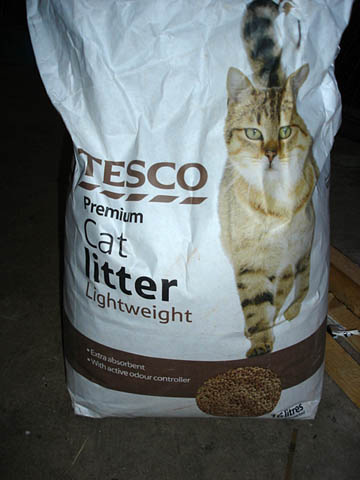
Tesco cat litter
It sounds like an interesting material to experiment with. The Japanese stuff I mentioned in the log looks rather different. The sample we have is rather coarse (though it does come in other grades) - here is a picture:
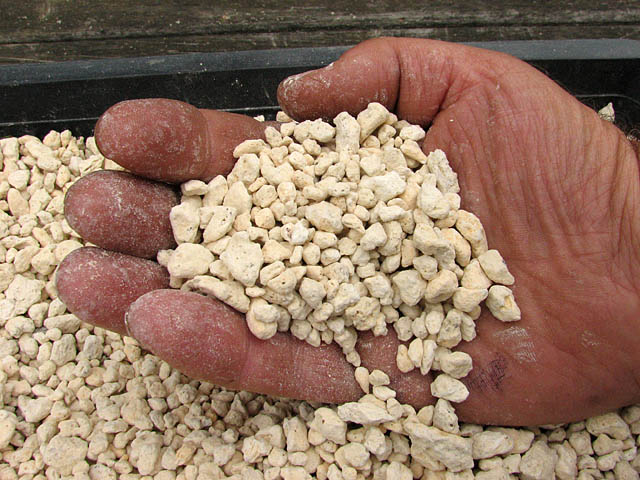
Japanese growing medium
I think this is probably "Kanuma", a Japanese medium often used by Bonsai growers. Can anyone confirm this for me, and if so what exactly is this material composed of? There is another Japanese material called Akadama which is redder in colour and may be the specific one used for Ponerorchis in Japan, but I need to check this out.
I can't leave the log without at least one flower picture this week! So here is Watsonia pillansii from South Africa, growing outside in our monocot border:

Watsonia pillansii
Here is the information on John Innes Composts:
John Innes Composts is a loam-based compost mix which was developed about 70 years ago. Before 1939 there were no standard potting ingredients or formulae for mixes. Growers would prepare individual mixes for each species, often being very secretive and guarding their recipes from competitors. Their ingredients included things such as chopped turfs, mortar rubble, crushed brick, burnt clay, charcoal, animal manures, spent hops and leaf mould. Two researchers, Lawrence and Newell, at the John Innes Horticultural Institution were investigating the high mortality rate in Primula sinensis seedlings being used for genetic studies. Their problem was partly caused by pathogens in their growing medium. This led them, in 1939, to develop a standardised medium suitable for a wide range of plants. These mediums became known as the John Innes Composts (JI composts). They differed from traditional composts in several important ways:
1. A single physical mixture was found to be suitable for a wide range of plants
2. They were steam-sterilised to eliminate heavy losses of seedlings resulting from soil-borne fungal and insect attacks
3. Peat was included as a relatively standard and sterile organic conditioner, replacing the rotted animal manures and other variable ingredients
4. Fertilisers were added with precision on a weight basis rather than the imprecise "handfuls" or "sprinklings" previously used
Two kinds of compost were formulated, one for seed sowing/rooting cuttings and one for potting. To allow for the varying vigour of different plants and seasonal changes in growth rates, the fertiliser levels were varied in the potting medium to have either double or triple the amount present in the basic mix. So the basic potting mix was called John Innes No. 1, that with double the fertiliser was John Innes No. 2 and that with triple the fertiliser was John Innes No. 3. The actual, original formulae are:
1. John Innes Seed Compost:
2 parts loam, 1 part peat, 1part grit. Fertilisers added are: Superphosphate at 1.186 g per litre of mix and calcium carbonate at 0.593 g per litre of mix
2. John Innes Potting Compost No. 1
7 parts loam, 3 parts peat, 2 parts grit. Fertilisers added are: Hoof & horn at 1.186 g/l of mix, Superphosphate at 1.186 g/l of mix, Potassium sulphate at 0.593 g/l mix and calcium carbonate at 0.593 g/l mix.
The researchers also described the quality and grade that each of the main ingredients should have- i.e. exactly the grade of grit, the type of loam, the type and pH of the peat fraction etc to be used. The quality of the ingredients can make all the difference between a good and a poor quality John Innes compost. Unfortunately, this mix wasn't patented and there are no regulations which force manufacturers to comply with the prescribed qualities. Gladly however, some manufacturers do guarantee their brand is "true to formula" and these can be relied upon. Indeed most of the reputable manufacturers belong to a trade association called the John Innes Manufacturers Association who try to ensure good quality. Any bag carrying their seal of approval should be a good guide to a quality compost. There are still a lot of issues around the use of John Innes composts, including quality issues, storage issues and environmental issues. You can find out a whole lot more information at www.johninnescompost.org and also at
the John Innes Manufacturers Association site at www.johninnes.info
^ back to the top ^
|

